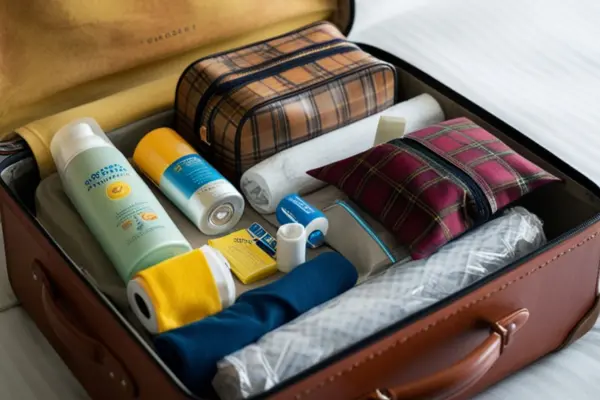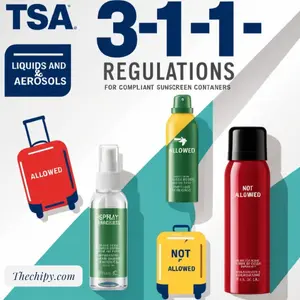When I was planning my recent vacation, I found myself wondering, “Can you bring spray sunscreen on a plane?” With TSA regulations and airline rules often seeming confusing, I knew I wasn’t alone in my concern. Spray sunscreen is a travel essential, especially when you’re headed to a sunny destination.
Thankfully, there are clear guidelines about bringing spray sunscreen on a plane. The TSA has specific rules for liquids and aerosols in both carry-on and checked baggage. Knowing these rules can help you pack smart and avoid any surprises at the airport. I’ll share everything I’ve learned about bringing spray sunscreen on a plane. From TSA regulations to safety tips, let’s dive in and make sure you’re well-prepared for your next trip!
TSA Regulations for Spray Sunscreen:
When it comes to bringing spray sunscreen on a plane, the Transportation Security Administration (TSA) has specific rules that travelers need to follow. Understanding these regulations is crucial to ensure a smooth security screening process.
According to the TSA, you can bring spray sunscreen in your carry-on baggage, but it must adhere to the 3-1-1 liquids rule. This means that each container must be 3.4 ounces (100 milliliters) or less, all containers must fit into a single, quart-sized, clear plastic zip-top bag, and each passenger is allowed only one such bag. This rule applies to all liquids, gels, and aerosols, including spray sunscreen.
For those who need to bring larger quantities of spray sunscreen, placing it in checked baggage is an option. The TSA allows larger aerosol containers in checked luggage, but there are still limits to consider. Each container must not exceed 18 ounces (532 milliliters), and the total aggregate quantity per person must not exceed 70 ounces (2 liters). It’s important to securely pack these items to prevent leaks or accidental discharge during transit.

Can I Bring Spray Sunscreen on a Plane in Checked Baggage?
Yes, you can bring spray sunscreen in checked baggage, and there are specific guidelines to follow to ensure it is allowed.
First, make sure each container does not exceed 18 ounces. The TSA permits travelers to bring multiple containers, but the total amount should not surpass 70 ounces. This means you can pack several bottles of spray sunscreen, as long as the combined volume stays within the allowed limit. Additionally, it is advisable to place the sunscreen containers in plastic bags to contain any potential leaks.
Packing spray sunscreen safely is essential. Consider wrapping each bottle in clothing or placing them in sturdy zip-lock bags to provide an extra layer of protection. This will help prevent any damage or accidental spraying caused by changes in air pressure during the flight.
Can You Bring Aerosol Cans on a Plane?
Aerosol cans are generally allowed on planes, but they must comply with TSA regulations to ensure safety.
For carry-on baggage, aerosol cans are subject to the 3-1-1 liquids rule. Each aerosol must be 3.4 ounces or less and fit into the quart-sized bag along with other liquids and gels. This rule applies to all aerosol products, including deodorants, hair sprays, and, of course, spray sunscreens.
For checked baggage, larger aerosol cans are allowed, but they must adhere to the quantity limits set by the TSA. Specifically, each aerosol can should not exceed 18 ounces, and the total combined volume of all aerosols must be no more than 70 ounces per passenger. Spray sunscreen falls under this category, so if you’re packing it in your checked luggage, be sure to count it toward this limit.
When traveling with aerosol cans, it’s also important to consider the flammability of the contents. Many aerosols, including spray sunscreens, contain flammable propellants. While these are generally safe when used correctly, they must be packed and handled with care to avoid any risks during your flight.
Is Spray Sunscreen an Aerosol?
To understand whether spray sunscreen is considered an aerosol, it’s important to first define what an aerosol is. An aerosol is a suspension of fine solid particles or liquid droplets in a gas. In the context of consumer products, aerosols are typically contained in a pressurized can and released as a fine mist when the valve is opened. Common examples include deodorants, hair sprays, and, indeed, spray sunscreens.
Spray sunscreen fits into this category because it is dispensed from a pressurized container in the form of a mist or spray. This method allows for even application over large areas of skin, making it a convenient option for sun protection. The propellants used in spray sunscreens help to distribute the sunscreen evenly and efficiently, but they also categorize these products as aerosols.
Is Spray Sunscreen Flammable?
The flammability of spray sunscreen is an important consideration for travelers. Many spray sunscreens contain flammable propellants, which are used to disperse the sunscreen from the can. These propellants are often hydrocarbons like butane, propane, or isobutane, which can ignite under certain conditions.
Spray sunscreens often contain a combination of ingredients that contribute to their effectiveness and ease of use. However, it is the propellants that primarily make them flammable. These propellants are highly volatile and can catch fire if exposed to an open flame or high heat. The sunscreen itself, typically composed of various oils and other compounds, may also be flammable to some extent, though it is generally the propellant that poses the most significant risk.
When traveling with flammable items such as spray sunscreen, it’s crucial to take certain precautions to ensure safety:
- Proper Packing: Always pack spray sunscreen in its original container and ensure the cap is securely fastened. For checked baggage, consider placing the can in a plastic bag or wrapping it in clothing to prevent accidental discharge.
- Avoid Heat: Keep spray sunscreen away from high temperatures. Do not leave it in direct sunlight or a hot car for extended periods, as this can increase the risk of the canister exploding.
- Follow TSA Guidelines: Adhere to the TSA regulations for aerosols, both in carry-on and checked baggage. Ensure that the total quantity of flammable aerosols does not exceed the allowed limits.
- Handle with Care: Be mindful when using spray sunscreen near open flames or while smoking. Apply the sunscreen in well-ventilated areas and allow it to dry before coming into contact with any potential ignition sources.
By following these guidelines, you can safely travel with sprayed sunscreen and enjoy your sunny destination without any unexpected issues. Understanding the nature of spray sunscreens as aerosols and their flammability can help you pack and use these products responsibly.
Frequently Asked Questions (FAQ)
What are the TSA limits for liquids and aerosols in carry-on bags?
The TSA limits liquids and aerosols in carry-on bags to 3.4 ounces (100 milliliters) per container. All containers must fit into a single quart-sized, clear plastic zip-top bag.
Can I use spray sunscreen on the plane?
Yes, you can use spray sunscreen on the plane. However, apply it carefully and avoid spraying near other passengers to prevent discomfort or accidental inhalation.
What happens if I bring more than the allowed amount?
If you bring more than the allowed amount, TSA may confiscate the excess items. You could also face delays or complications at the security checkpoint.
Conclusion:
In summary, you can bring spray sunscreen on a plane by following TSA regulations for both carry-on and checked baggage. Remember to adhere to the 3-1-1 rule for carry-ons and pack checked items securely. Following these guidelines ensures a smooth travel experience and avoids surprises at security checkpoints. Preparing ahead of time helps make your journey stress-free and enjoyable.
